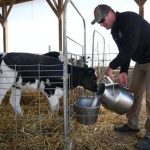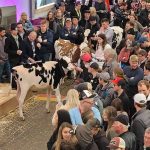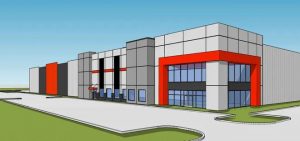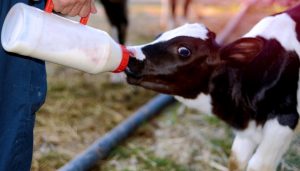
“When the dairy industry first started doing beef on dairy, it was just, ‘Give me a black bull,’” says David Erf, senior veterinarian of dairy technical services with Zoetis. “There was no concern about the quality of the beef carcass. The attitude was ‘anything is going to be better than a purebred Holstein bull’.”
In the last four years, crossbreeding beef sires with dairy cows has gained popularity as an extra value-added income for most dairy farmers. According to Penn State, in 2021, artificial insemination technicians sold over 8 million units of beef semen to dairies nationwide. It’s a 44% increase from the 6 million units sold in 2018.
Breeding dairy beef has also become more cost-efficient than breeding replacement heifers, says Andrew Greenleaf, a Select Sires reproductive specialist.
Most of Greenleaf’s customers in Berks, Chester, and Lancaster County, Pennsylvania, say purchasing replacement heifers is more economical than raising their own. Greenleaf says the drivers behind that have been high feed costs and tighter milk prices.
“Some dairy farmers can get twice as much money for an Angus cross than a purebred Holstein bull calf,” Greenleaf says.
About 99% of Greenleaf’s customers choose semen from an Angus bull, such as Hoffman Stagecoach, a moderate-size black Angus bull with high performance traits in calving ease and weaning weight.
Stagecoach also has high fertility rates and is cost-effective. Greenleaf says that dairy farmers can get five frozen semen straws for $25, a good bargain for most farmers.
“I am seeing dairies doing beef on dairy crosses, looking more at the genetics of the beef bulls they’re using. So they are making sure they are selecting a bull with a big ribeye, all those great carcass and growth traits from an average daily gain advantage,” says Erf.
WHAT BREED IS THE BETTER BEEF BULL?
Recently, researchers at Penn State have stepped in to help dairy farmers become more genetically efficient with raising dairy beef crosses with a study titled investigating the genetics of beef-sired steers born to Holstein cows.
Tara Felix, an associate professor and the study’s principal researcher, published her results from the continuing four-year study of beef-sired Holstein cross feedlot trails. This year’s study focused on 124 dairy beef steers sired by Angus, Charolais, SimAngus, and Wagyu bulls.
After being fed a milk replacer and weaned on free-choice starter grain for seven weeks, the steers were finished on a standard corn and corn-silage-based diet and slaughtered after 90 to 153 days on feed.
Felix says the Angus-sired dairy beef averaged around 966 pounds. They were the heaviest in the feedlot and on the rail. The steers also were the only ones in the group that spent the shortest amount of time on feed.
Felix also notes that the Charolais-sired steers outperformed the Wagyu and SimAngus Holstein crosses. In addition, the study found that the SimAngus-sired and Wagyu-sired dairy beef spent the most days on feed and were the lightest, with weight ranges between 738 pounds and 783 pounds at slaughter.
The Wagyu breed has become popular in the beef industry in recent years because many consumers will pay a premium for its rich buttery eating experience, says Felix. And so, she was astonished by the low performance of the Wagyu-sired Holsteins.
Out of the several crossbreds, the Wagyu-Holsteins spent 161 days on feed. The steers also had the lowest dry matter intake and average daily gain compared to the other crosses. In addition, most of the Wagyu-Holsteins had the lightest carcass — an average of 1,260 pounds at slaughter — and had the least amount of back fat.
Felix says the study confirms that dairy farmers should focus on something other than chasing a beef fad like Wagyu and look at alternative beef breeds that could be more efficient on feed and, ultimately, more profitable long-term.
Around 84% of the steers that graded Choice were Angus-sired dairy beef. She says most of the other carcasses averaged at Yield Grade 2, meaning they had less lean and edible meat for retail.
DAIRY BEEF HELPS THE BEEF SUPPLY CHAIN
As consumer demand for beef increases and the average number of beef cattle in feedlots dwindles due to current drought conditions in the West and Midwest, beef packers are leaning more on the dairy industry to supplement supplies with beef-sired dairy cross steers.
“Feedlots are more seasonal, and dairy herds are not. Dairy beef calves can flow through feedlots year round,” says Erf.
Erf adds that another benefit of dairy beef for packers is traceability, a subject that neither industry has capitalized on.
“The concept of farm to table is about traceability, and dairy farms have the tools in place to provide that,” he says.
Dairy farmers are required to identify every animal in their herd with a premise tag, and it stays with the animal throughout its life to provide a data stream of that animal from birth until death. It’s like an age source verification, says Erf.
Greenleaf says the future for beef on dairy breeding will remain a hot commodity on dairy farms for a while.
He adds that there are many more marketing opportunities for dairy farmers, either by contracting with feedlots or directly marketing dairy beef to consumers.
“What started with one or two doing it here and there is now a growing trend,” says Greenleaf.




















